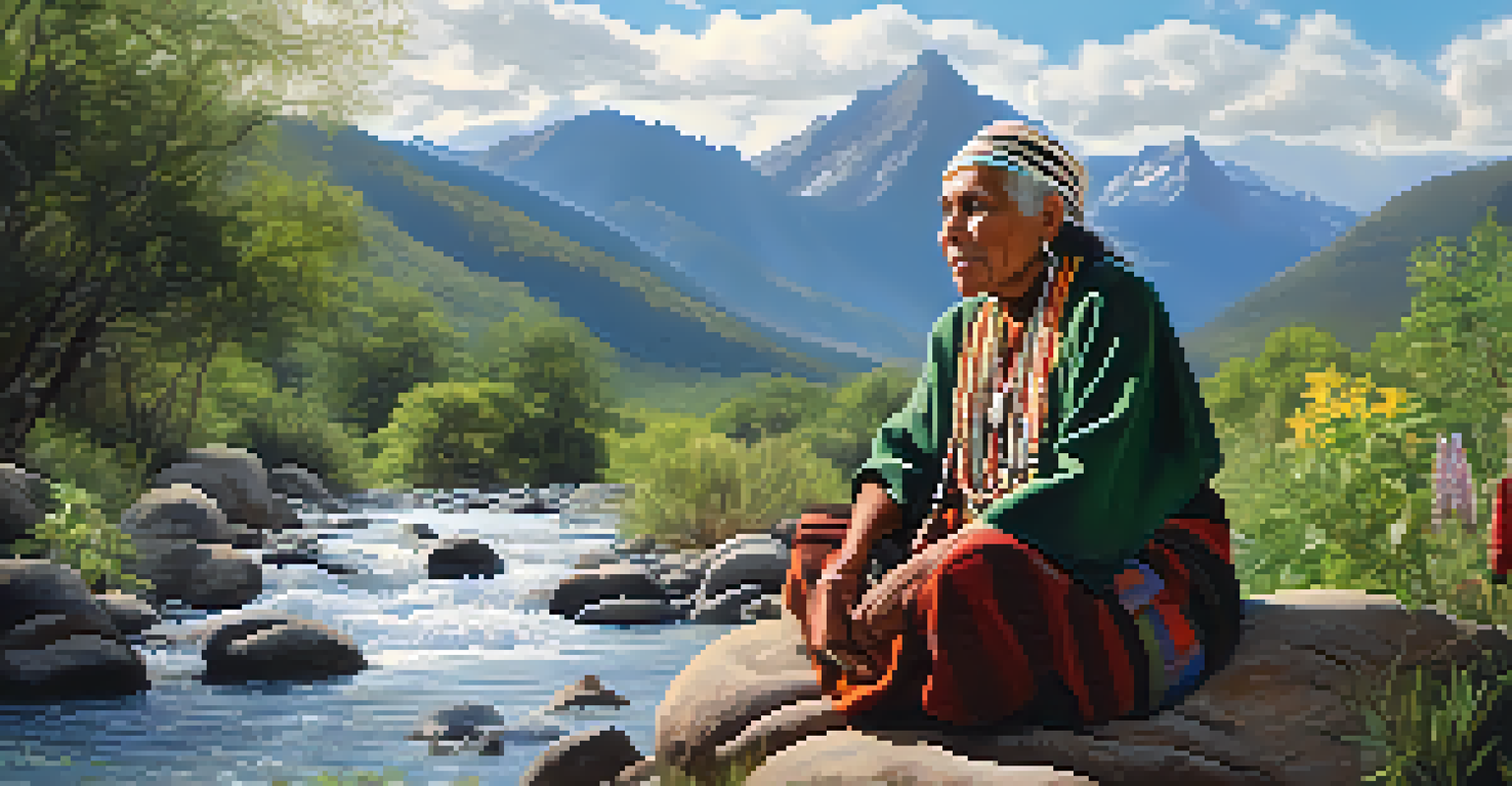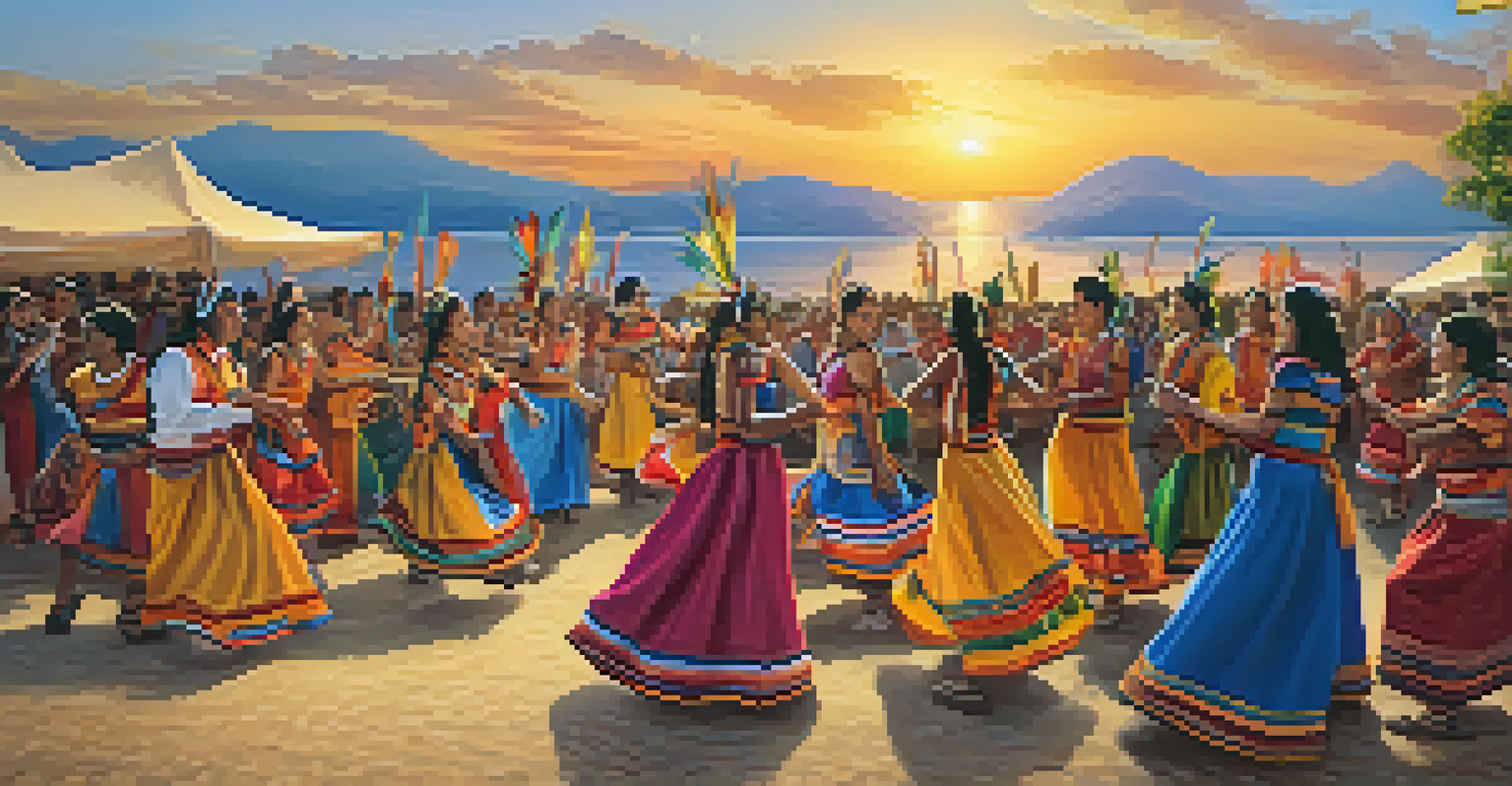Understanding Healing Traditions in Indigenous Cultures Today

The Roots of Indigenous Healing Traditions
Indigenous healing traditions are deeply rooted in the cultures and histories of Native peoples. These practices blend spiritual, physical, and emotional healing, often relying on nature and community. Understanding these roots helps illuminate the holistic approach Indigenous cultures take towards health and wellness.
The land is the source of life; it is the essence of our being, and it teaches us how to heal.
Many Indigenous communities view health not just as the absence of illness but as a balance between the individual and their environment. This interconnectedness is reflected in various practices, such as herbal medicine, rituals, and ceremonies. By honoring ancestors and traditions, these healing methods foster a sense of belonging and identity.
Today, these traditions are being revitalized as communities seek to reclaim their heritage and promote wellness. They serve as a reminder that healing is a shared journey, one that often involves the wisdom of elders, community participation, and respect for the land.
The Role of Nature in Indigenous Healing
Nature plays a pivotal role in Indigenous healing traditions, often serving as both a source of medicine and a spiritual guide. Plants, animals, and natural elements are used in various rituals, highlighting the belief that everything is interconnected. This relationship with nature cultivates a profound respect for the environment and its resources.

For instance, many Indigenous healers use specific herbs known for their medicinal properties, such as sage for purification or cedar for protection. These natural remedies are not only effective but are also accompanied by cultural significance and teachings. Engaging with the land in this way fosters a deeper understanding of one's surroundings.
Holistic Approach to Healing
Indigenous healing traditions emphasize the interconnectedness of spiritual, physical, and emotional wellness.
In today's context, the emphasis on nature in healing has found resonance among broader communities, leading to a resurgence in herbalism and eco-therapy. This reflects a growing awareness of the benefits of reconnecting with nature for mental and physical health, bridging the gap between traditional practices and modern wellness.
Healing Through Rituals and Ceremonies
Rituals and ceremonies are central to Indigenous healing practices, serving as a means of connecting individuals to their culture and community. These gatherings often involve music, dance, and storytelling, reinforcing the bonds among participants and the shared values of the community. They create a sacred space for healing to occur.
Healing is a matter of time, but it is sometimes also a matter of opportunity.
For example, sweat lodge ceremonies are used for physical purification and spiritual renewal. Participants often share their intentions and experiences, fostering a sense of vulnerability and support. This communal aspect of healing emphasizes that no one is alone in their journey.
As these ceremonies gain recognition, they are increasingly adapted and included in wellness programs outside Indigenous communities. This adaptation reflects a broader appreciation for the power of community and ritual in promoting healing, showing how ancient practices can inform modern approaches.
The Importance of Elders in Healing Practices
Elders hold a revered position in Indigenous cultures, often acting as healers, teachers, and spiritual guides. Their wisdom is not only based on lived experience but also on the transmission of knowledge across generations. This connection to the past enriches the healing process and fosters respect for cultural traditions.
In many communities, seeking guidance from an elder is a vital step in the healing journey. Elders often conduct healing ceremonies and offer insights that reinforce the importance of cultural identity and community ties. Their role underscores the collective aspect of healing, reminding individuals that support is always available.
Role of Nature in Healing
Nature serves as a vital resource and spiritual guide in Indigenous healing practices, fostering respect for the environment.
As more people seek to understand and integrate Indigenous healing practices, the wisdom of elders becomes increasingly valuable. Their teachings provide a bridge between ancient knowledge and contemporary healing, emphasizing the importance of honoring traditions while adapting to modern needs.
Modern Challenges Facing Indigenous Healing Traditions
Despite their resilience, Indigenous healing traditions face numerous challenges in the modern world. The encroachment of Western medicine and the loss of traditional lands have significantly impacted these practices. Many Indigenous healers are striving to maintain their traditions in the face of cultural assimilation and globalization.
Additionally, there is a growing concern about the commercialization of Indigenous healing practices. As interest in these traditions increases, some aspects risk being commodified, stripping them of their cultural significance. This situation prompts a critical conversation about ethical practices and the importance of honoring the origins of these traditions.
However, many Indigenous communities are actively working to revitalize their healing practices. By educating others about their cultural significance and advocating for their rights, they aim to ensure that these traditions thrive for future generations.
Integrating Indigenous Healing in Today’s Healthcare
The integration of Indigenous healing practices into mainstream healthcare is an emerging trend that holds promise for holistic wellness. Healthcare providers are starting to recognize the value of combining traditional medicine with conventional treatments. This approach not only benefits Indigenous patients but also enriches the overall healthcare experience.
For instance, hospitals and clinics are increasingly collaborating with Indigenous healers to offer culturally relevant care. This collaboration often leads to better health outcomes, as it respects and incorporates the beliefs and values of Indigenous patients. It highlights the importance of personalized care that acknowledges the whole person.
Elders as Cultural Guides
Elders play a crucial role in passing down healing knowledge and cultural traditions, enriching the healing journey for individuals.
As this integration continues, it can serve as a model for how different healing traditions can coexist within the healthcare system. By valuing diverse perspectives and practices, we pave the way for a more inclusive approach to health and wellness.
The Future of Indigenous Healing Traditions
The future of Indigenous healing traditions looks promising as younger generations take an active role in preserving and revitalizing their cultural practices. Many Indigenous youth are returning to their roots, learning from elders, and participating in healing ceremonies. This resurgence fosters a sense of pride and cultural identity.
Moreover, the increasing interest in holistic health and wellness among broader communities presents opportunities for Indigenous practices to be shared and appreciated. By engaging in respectful dialogue and collaboration, both Indigenous and non-Indigenous communities can learn from one another, enriching the healing landscape.

Ultimately, the survival of Indigenous healing traditions will depend on the commitment of communities to protect their heritage and adapt to changing circumstances. By fostering a sense of respect and understanding, we can ensure that these invaluable traditions continue to thrive for generations to come.